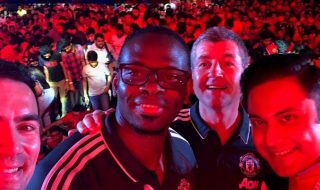

Sweet and sublime yet bold and powerful, slow and toned down yet swift and apologetically alluring, soft and soothing yet ferocious and strangely very captivating, a night where only the acts of legends could bring out such myriad adjectives. A confluence of the greatest of greats under the same roof; performing, sharing stories, improvising and setting an example, a rare treat I would say nowadays.
AJIVASAN – A Guruji’s gift to the world
The event was organized to celebrate the centenary year of NGO, Acharya Jialal Vasant Sangeet Niketan (AJIVASAN). The NGO, earlier known as Vasant Sangeet Vidyalaya, was founded in 1932 by Acharya Jialal Vasant, who was an Indian classical musician and teacher. The NGO was later passed on to renowned playback singer Shri Suresh Wadkar and his daughter Prem Vasant in 1986.
The institute has a reputation of using scientific tools and techniques for teaching Indian Classical Music. The Niketan is a result of a Guru with a vision and passion for turning the heart of the world towards the universality and magnanimity of Indian Classical Music.
The noble idea for the ‘Legends’ here was to raise money for the under privileged children, who are taught, empowered and taken care of by the NGO AJIVASAN.
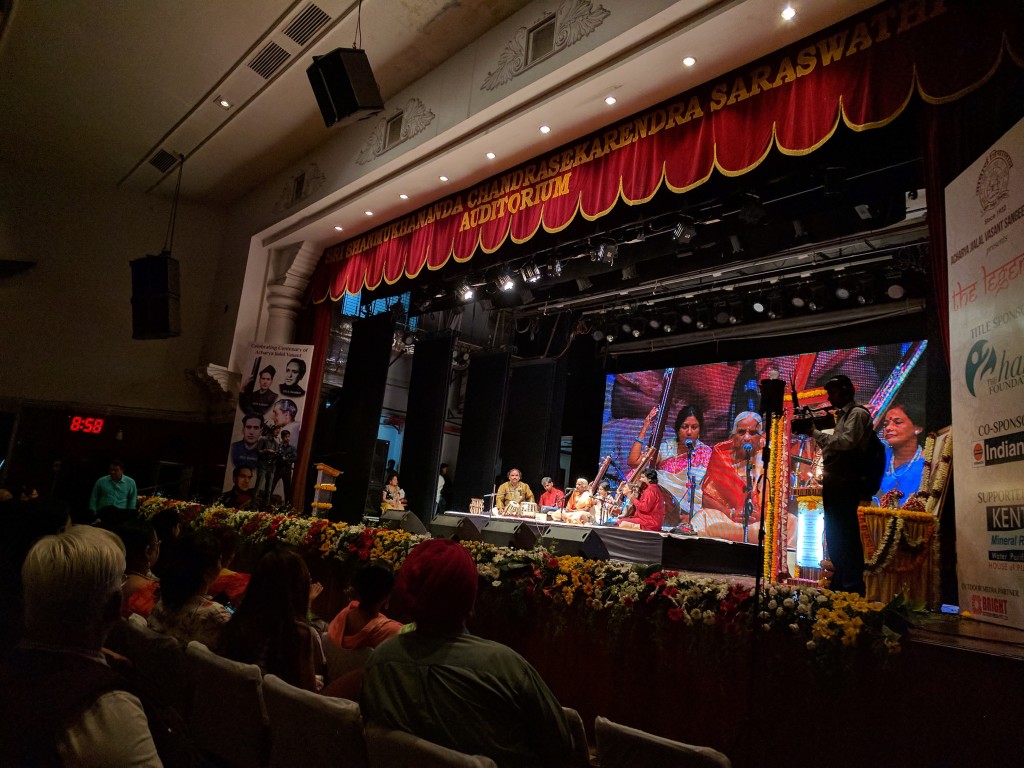
Shanmukhananda Hall – A living tradition, A tradition of excellence
From plush seating accommodations to the intricate, ornate decorations ; from the incredible acoustics for superior sound to the amazing lightings, Shanmukhananda Hall is more than an edifice; it is now the symbol of Indian cultural history.
The hall has witnessed a wide range of performances; from lilting vocal ones to the sweet strains of a veena recital; from the intricate and refined movements of a Bharatnatyam dance to a large political gathering, the hall has seen it all.

Located at the heart of Mumbai, near King’s Circle railway station, this magnificent hall is a great asset for Mumbai; a great asset for arts and culture.
As the audience started pouring in and the clock struck six in the evening, Mrs. Prem Vasant, daughter of Shri Jialal Vasant, took to the stage to welcome one and all. She then introduced the audience to RJ Rahat Jafri of Radio Mirchi 98.3 FM, as the host of the evening. Rahat with her deep resonating voice started briefing us about the vision of AJIVASAN.
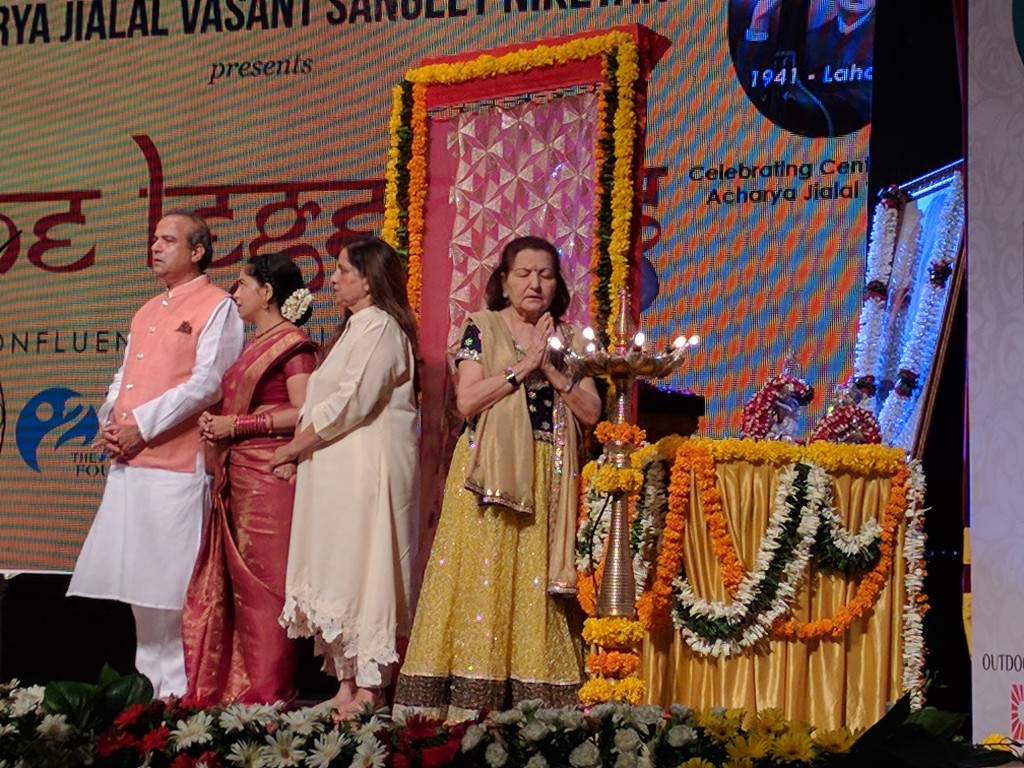
Apart from Mrs Prem Vasant, the renowned singer Suresh Wadkar and his wife were introduced. Shortly after the introductions, a video of AJIVASAN was played on the giant screen. The video showcased the musical talents of the differently-able children, where they sang along with their teacher. Also many of them were taught to play various instruments. It was really an inspirational video with a very strong message: a message of immense positivity and hope.

The first performance of the evening was not by any Legend, but by a group of children and teenagers who sang like Legends. The performance started just after lighting of the lamps to seek blessings from Goddess Saraswati. Their vocal ranges were stunning; consisting of many beautiful ornamentations. The group consisted of no rookies but Maestros in disguise possessing immense potential to carry the legacy of Indian Classical music forward.
Rahul Sharma :- The Santoor Maestro with a modern touch
As per the schedule, the first act of the evening was reserved for Pt Shiv Kumar Sharma but unfortunately he was not able to stage the performance for the reason that his flight to Mumbai was delayed. In lieu of him, his son Rahul decided to stage the performance.

I had previously listened to some of Rahul’s songs and compositions, which would eventually make me a big time Santoor fan. Especially I had loved Rahul’s collaboration with the legendary Grammy award winning Saxophonist Kenny G; their album titled ‘Namaste’. ‘Silsila’ is one of the songs which I really loved from the album.
As a result I was equally excited for the Rahul’s performance. Santoor, the instrument played by Maestro Rahul, is an ancient hammered 100 stringed trapezoidal dulcimer made of walnut or maple woods. It is played by hammering on the strings by light wooden mallets or tongs. When played, the distinctive sounds evoke a rich feeling of traditional Middle Eastern ‘Soofiyana’. Oh did I mention that Santoor is the national instrument of Iran? No. Then I should mention that it is indeed.

A quick introduction and then, the duo of Maestro Rahul Sharma and the tabla player took us through a journey of melodic cliffs and peaks of an ancient Indian Classical Raag called Raag Bhoop. It is a very soothing raga and when played on a santoor, the music leaves you with a long lasting feeling of joy and ecstasy.
Maestro Rahul Sharma used the mallet to just glide over the strings without directly hitting them, creating a slurry sound, a highly interesting and delicate technique. Combined with the extraordinary timing of Rahul’s strike on santoor and the stroke of the tabla, anyone will be awed by the intricacies along with the mesmerizing musicality of the duo.
In the end Maestro Rahul who had big shoes to fill, for he was performing instead of his father Pandit Shiv Kumar Sharma, has emerged out as a champion who enthralled everyone with his expertise on santoor.
After the superb performance, the Honorable Education minister of Maharashtra, Shri Vinod Tawde was invited on the stage by the host Rahat. All the performers were also requested to come up to the dais to unveil the bust of Shri Jialal Vasant. His daughter, Smt. Prem Vasant, gently removed the curtain of flowers covering the bust and everyone in the hall clapped.

Education minister gave a short speech mentioning the importance of arts and culture to be imbibed in every child in school. He said that in educational institutions children are taught only to raise their IQ (Intelligence Quotient). However nobody teaches them to augment their EQ (Emotional quotient). Only arts, music and culture have the immense power to tap into our EQ.
Pandit Hariprasad Chaurasia:- God’s own breath
Upon asking Pandit Hariprasad Chaurasia why he chose flute over other musical instruments, his reply was “Bansuri kabhi besuri nahi hoti!” It meant that flute never goes out of tune.
The living legend Pandit Hariprasad Chaurasia needs no introduction. He has received Sangeet Natak Academy, Padma Bhushan and Padma Vibhushan just to name a few. He plays the Indian bamboo flute (Bansuri) from the left side (a unique style in itself). It is said that Panditji started playing from left side to show his devotion towards his teacher, where he previously played flute from right side. He has enchanted millions across the globe, collaborated with national artists like Pandit Shiv Kumar Sharma and even international artists like John Mc Laughlin and Beatles to name a few.
The soulful and profound voice of the flute brings an immediate calmness and feeling of ease to any person. Pandit Hariprasad Chaurasia has over the years perfected so well that for many he is the very definition of Lord Krishna playing Bansuri.
Accompanying the pandit was another influential and ace percussionist by the name of Bhawani Shankar. He plays an Indian drum by the name Pakhvaj.
The Pakhvaj is a barrel shaped two headed drum which has a low mellow tone and is very rich in harmonics, thus creating an euphonic sound perfect for the Indian classical genre.
The first piece played by Panditji and his team was Raag Jog. It is a bluesy kind of Raag which gives a tension like feel .A perfect Raag to be played in late evenings.
Panditji’s act began slowly with a call and response mechanism and sustained notes on the Bansuri on the back drop of a rhythm of Tanpura.
Tanpura, which is a long necked plucked string instrument, does not play any melody rather it supports by providing a continuous harmonic drone or rhythm. During the proceeding of the raga, the sweet sound of flute would be backed by the thunderously melodic Pakhvaj and by the sublime Tabla.

After almost alf an hour of Raag Jog, Panditji and his troupe played another Raag called Raag Durga. Wow, what a sweet and mellow Raag. When played on flute by Panditji, the outcome was pure bliss. The tempo of Raag Durga was a bit faster than Raag Jog and both the Pakhvaj and the tabla were used, the combination was mellifluous. The nocturnal Raag was the perfect anecdote to compliment the mood of the audience.
Playing Bansuri at the age of 79 is no easy feat. It requires a lot of stamina and power to control the breathing. No wonder Panditji was a son of a wrestler. Panditji played Bansuri with such an ease that the instrument had become a part of him, like a symbiotic relationship. He is an asset to Indian Classical music whose works are remembered and cherished by one and all.
After the performance of Panditji, another aha moment came when the legendary singers Sonu Nigam and Hariharan came out of the audience to celebrate the Indian classical music. Sonu and Hari haran instantly took to stage to congratulate and touch the feet of Panditji. Truly it was a confluence of Gods.
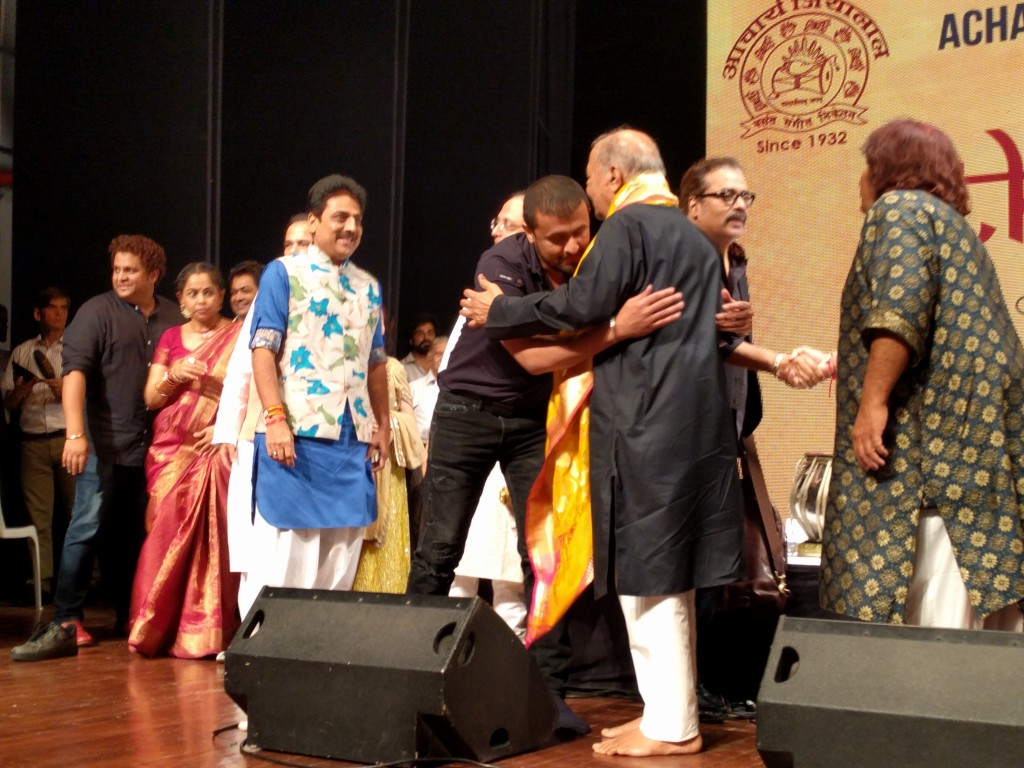
Vidushi Girija Devi – The voice of Benaras
From the Gharana of world’s oldest city, Benaras, resonates a voice as powerful as the roots of an strong old Banyan tree.
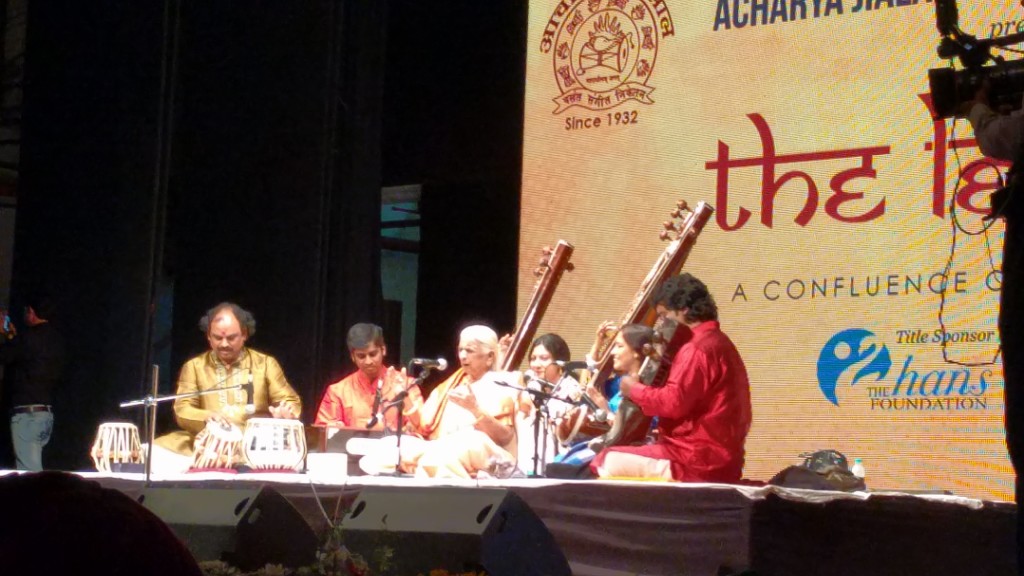
Vidushi Girija Devi’s voice emerges from somewhere within , grounded firmly as if it were subterranean, rising slowly as it reaches the peak , at a point that it becomes so sharp and clean that the sound of her voice reverberates in the silence. Girija Devi is one of India’s greatest vocalists. One of the last masters of the Benarasi Gharana, Devi has been equally and effectively singing in the traditional classical style of Khyal as well as semi-classical styles such as Thumri, Kajri, Dadra and Chaiti. The recipient of prestigious Padma Shree award and the Padma Bhushan, she has also received the Sangeet Natak Academy awards of Uttar Pradesh and Delhi.
Vidushi Girija Devi’s ensemble played Tabla, Harmonium, Tanpuras and Sarangi. These instruments sang in the tunes of another Indian classical Raga called Raga Bihag. A celebratory Raag with a touch of romanticism usually played in the second quarter of the night.
Girija Devi’s warm and homely voice took us instantly from Mumbai to the royal palaces of ancient Kings and Queens of Uttar Pradesh. Soon we realized what the word Gharana meant.

Next up Vidushi Girija Devi sang a Thumri by the name ‘Jhanana jhanana mori baaje payaliya’. A Thumri is romantic or a devotional semi classical song involving a girl’s love for Lord Krishna. It had a call and response type of structure where Girija Devi sang the first two words ‘Jhanana Jhanana’ while the other vocalists sang the rest ‘mori baaje payalia’. Also included were vocal ornamentations by Devi in between.
After the Thumri, Vidushi Girija Devi sang a semi-classical piece by the name ‘Chaiti’. It is usually sung in the Hindu Calendar month of Chait, mostly around the occasion of Ram Navami. The Chaiti was a bit fast paced than the Thumri and was devoted entirely to Lord Rama. The Chaiti had the beauty in the music as well as in the lyrics.
Even at the ripe age of 86, Vidushi Girija Devi had the power in her voice to take us to different places and long forgotten times. She is an asset to Indian Classical music, an inspiration and a living Legend.
Again after Vidushi Girija Devi’s performance Sonu Nigam and Hari Haran took to stage to touch her feet and hug her.
Hema Malini –the eternal dream girl of Bollywood
If you ask anyone who is Hema Malini, that person will say she is an actress and a dancer in a split of a second. Such is Hema’s charm and popularity that everyone is quickly acquainted with her movies and achievements. She needs no introduction and any word said about her will be less. A recipient of Filmfare Award for best actress, Filmfare Lifetime Achievement award and Padma Shri to name a few, Hema Malini is the eternal dream girl of Bollywood.
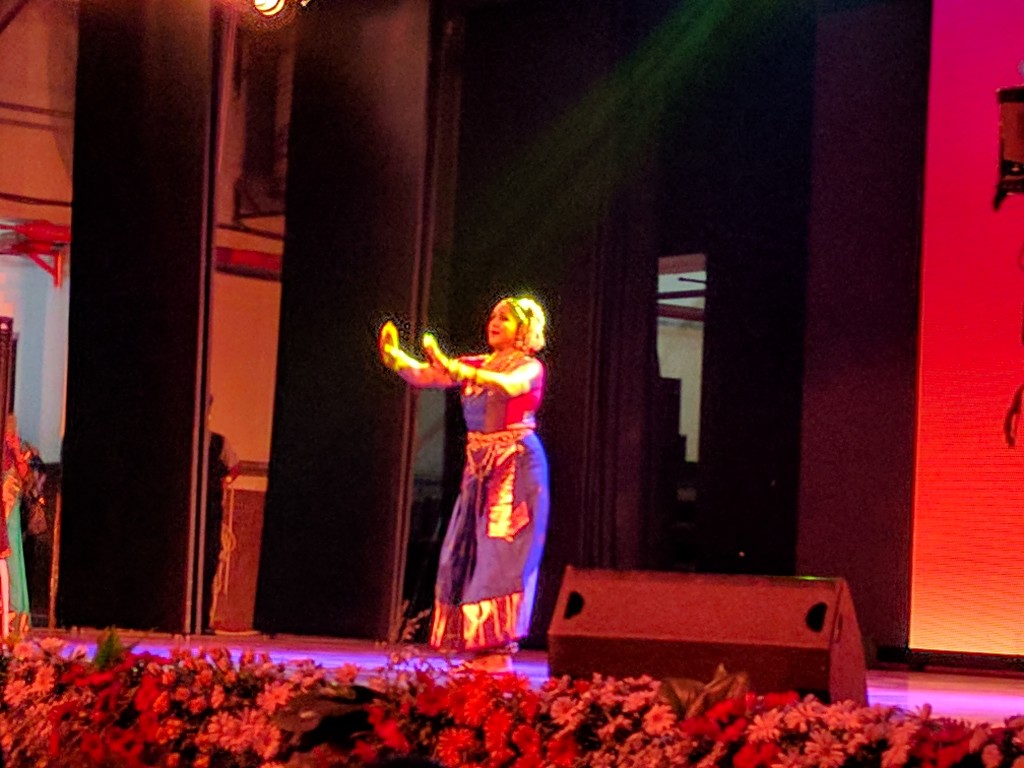
A prodigious dancer with expertise in Bharatnatyam, Kuchipudi and Mohiniattam, Hema Malini still had the elegant moves and fluid expressions at the age of 68. She took to the stage with a Bharatnatyam styled dance which had uncomplicated moves yet delivering all the message of the classical song played in the background.
Following the first Bharatnatyam she performed another Bharatnatyam and a Mohiniattam, where the Bharatnatyam one was danced in devotion to Lord Shiva. There Hemaji displayed the ferocious attributes of Lord Shiva along with his gentle side. The performance had her traverse the entirety of the stage to portray the myriad form of Shiva.

The Mohiniattam performance was about about a sweet conversation between Lord Rama and his mother (The event was organized on Mother’s Day, so a brilliant symbolism). The act had Hema ji display all the intricate and small details of their emotions and reactions in the on going conversation.
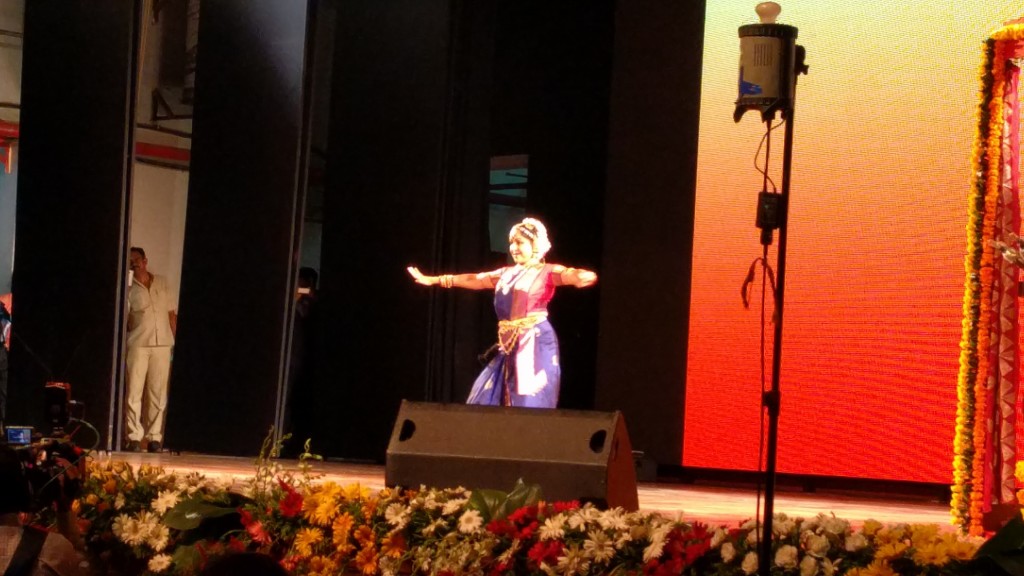
In the end we were amazed and spell bound by the grace and charm of Hemaji who danced to her full even at the age of 68. Only a person with such divine talent can pull off such a physical form of art known as dance. We left the hall feeling blessed and with a sense of achievement that we got to see these Legends live!
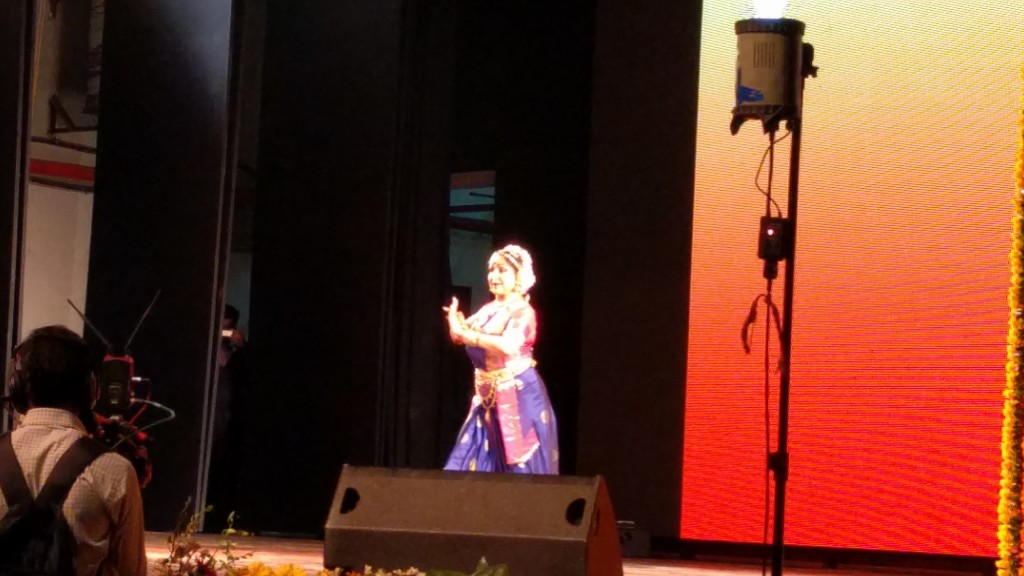
A note on Indian Classical Music :- Throughout my entire review I have mentioned Indian Classical music many times. Let us try to analyze the importance and heritage of the same.
Much like the country it originates from, Indian classical music is diverse and full of contrasts. Sandwiched between euphoric highs and devastating lows, there is sadness, happiness, excitement and everything in between. It is a combination of different musical scales (ragas) and rhythmic patterns (talas) in two different major sub genres (Indian and Carnatic), sung in different languages and performed on different instruments.
Ask any Indian classical music aficionados, they will tell you that you need not know any of the technicalities to fall in love with the genre, the secret is to let go of the technical comprehension and lose yourself in the music.
As with any other genre, this genre is constantly evolving under the influence of the many other Indian and western sub-genres like Bollywood, semi-classical, devotional, rock, jazz and the list goes on.
Conclusion:- Personally I am a man of Jazz, Blues and Rock n Roll. I like to listen to Indian Classical music when I am studying or concentrating on certain task. After watching the Legends perform in Shanmukhananda Hall, not only I am inspired to listen more but was inspired enough to play the different Raagas on my guitar and fuse them with the elements of Jazz, Blues and Rock.
This has been my take away from the concert and I will forever consider myself fortunate to witness such an event. Let the purity of Indian classical music enlighten more people and the live forever the musicians who have associated themselves with this genre. God bless music! Cheers!


